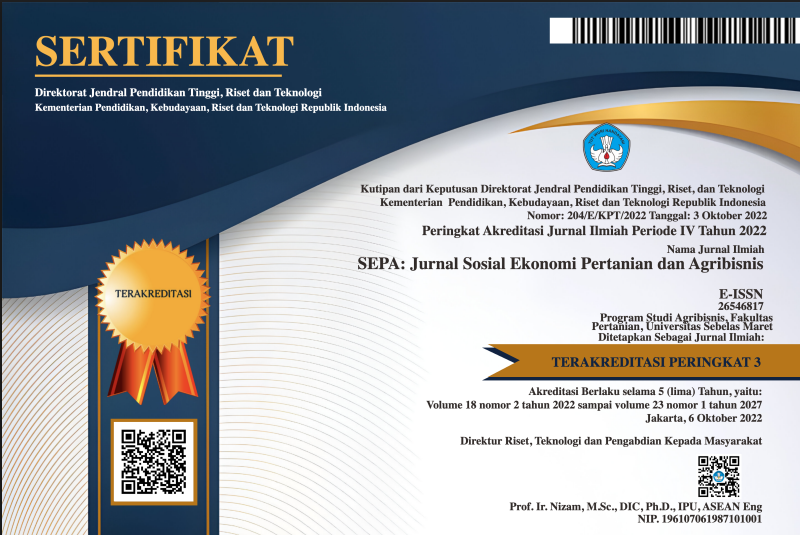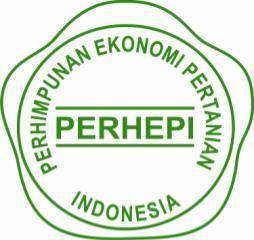MAKSIMALISASI KEUNTUNGAN DENGAN KENDALA FAKTOR-FAKTOR PRODUKSI PADA KEDAI KOPI BNO
Abstract
Kedai Kopi BNO is one of the coffee shop in Balikpapan City. However, in the last 3 months (February-April 2021) their income has decreased. It caused by the use of production factors that are less than optimal. The purpose of this study are to analyzed the maximum profit that can be obtained from the results of linear programming analysis, and also to analyzed the sensitivity to changes in variables from the results of linear programming analysis. This research was conducted in May 2021. Data processing is using Microsoft Excel Data Solver software. The result of linear programming analysis is that the maximum profit that can be obtained by Kedai Kopi BNO is Rp11,498,448.98 per month. Utilization of roasting coffee, mineral water, liquid sugar, and labor hours is optimal. Business actors can only change the value of profits and the amount of raw materials between the minimum and maximum limits so that the production activities could continue to run at the recommended optimum level.
Keywords
Full Text:
PDFReferences
Asmara, T., Rahmawati, M., Aprilla, M., Harahap, E., & Darmawan, D. (2018). Strategi Pembelajaran Pemrograman Linier Menggunakan Metode Grafik dan Simpleks. Teknologi Pembelajaran, 14(1), 506–514.
Christian, S. (2013). Jumlah Produksi Dalam Memperoleh Keuntungan. Journal The WINNERS, 01(14), 55–60.
Dewi, S. D. ., Tastrawati, N. K., & Sari, K. (2014). Analisis Sensitivitas dalam Optimalisasi Keuntungan Produksi Busana dengan Metode Simpleks. Jurnal Matematika, 4(2), 90–101.
Haslan, R., Supriadi, N., & Nasution, S. P. (2018). Optimalisasi Produksi Kopi Bubuk Asli Lampung dengan Metode Simpleks. Teori Dan Terapan Matematika, 17(2), 25–34. https://doi.org/10.29313/jmtm.v17i2.3852
Heizer, J., Render, B., & Munson, C. (2017). T Welf T H Edit Ion Oper At Ions. Pearson Education.
Igiasi, T. S. (2017). Kedai Kopi sebagai Ruang Publik: Studi Tentang Gaya Hidup Masyarakat Kota Tanjungpinang. Jurnal Masyarakat Maritim, 1(1), 18–20.
Julianti & Djunaedi, N. (2019). Strategi Manajemen Pasokan Dan Biaya Produksi Di Kedai Kopi. Ilmiah MEA (Manajemen, Ekonomi, & Akuntansi), 3(2), 01. https://doi.org/10.31955/mea.vol3.iss2.pp19
Krajewski, Lee J., Ritzman, Larry P., & Malhotra, M. K. (2013). Operations management. In Solutions: Business Problem Solving. Pearson Education. https://doi.org/10.1201/9781420065541.ch22
Panggabean, D., Djalal, M., & Santosa. (2014). Pada Pengolahan Rendang Di Perusahaan. Jurnal Optimasi Sistem Industri, 13, 427–453.
Pianda, D. (2018). Menentukan Kombinasi Produk yang Optimal dengan Metode Linear Programming. CV. Jejak.
Risanto, J. (2012). Algoritma Penyelesaian Masalah Linear Programming pada Efisiensi Bahan Baku Produksi untuk Varian Produk Mie bagi Pedagang Makanan. SATIN-Sains Dan Teknologi Informasi, 1(2), 99–105.
Solikatun, D. T. K., & Argyo, D. (2015). Perilaku Konsumsi Kopi Sebagai Budaya Masyarakat Konsumsi: Studi Fenomenologi Pada Peminum Kopi di Kedai Kopi Kota Semarang. Jurnal Analisa Sosiologi UNS, 4(1), 60–74.
Sukatmadiredja, N. R. (2013). Analisa Perubahan Perilaku Konsumen. Journal of Chemical Information and Modeling, 53(9), 1689–1699.
Talakua, E. G. (2017). Optimasi Faktor Produksi untuk Maksimasi Keuntungan Usaha Budidaya Rumput Laut di Desa Sathean Kecamatan Kei Kecil. Sosial Ekonomi Kelautan Dan Perikanan, 12(1), 45–56.
Teguh, M. (2014). Metode Kuantitatif untuk Analisis Ekonomi dan Bisnis. Rajawali Pers.
Yulianto, Herry Dwie; Sutapa, I. N. (2005). Riset Operasi dengan Excel. CV. ANDI OFFSET.
Yunus, A. S. (2018). Panduan Pendirian Usaha Kedai Kopi. Badan Ekonomi Kreatif.DOI: https://doi.org/10.20961/sepa.v21i1.56249
Refbacks
- There are currently no refbacks.



.png)







.png)
3.png)





